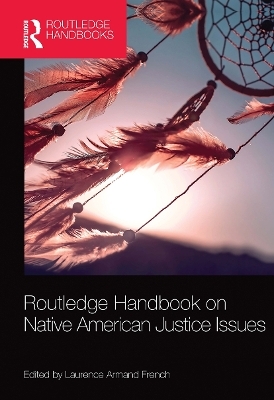
Routledge Handbook on Native American Justice Issues
Routledge (Verlag)
978-0-367-53093-8 (ISBN)
Native Americans are disproportionately represented as offenders in the U.S. criminal justice system. Routledge Handbook on Native American Justice Issues is an authoritative volume that provides an overview of the state of American Indigenous populations and their contact with justice concerns and the criminal justice system. The volume covers the history and origins of Indian Country in America; continuing controversies regarding treaties; unique issues surrounding tribal law enforcement; the operation of tribal courts and corrections, including the influence of Indigenous restorative justice practices; the impact of native religions and customs; youth justice issues, including educational practices and gaps; women’s justice issues; and special circumstances surrounding healthcare for Indians, including the role substance abuse plays in contributing to criminal justice problems.
Bringing together contributions from leading scholars – many of them Native Americans – that explore key issues fundamental to understanding the relationships between Native peoples and contemporary criminal justice, editor Laurence Armand French draws on more than 40 years of experience with Native American individuals and groups to provide contextual material that incorporates criminology, sociology, anthropology, cultural psychology, and history to give readers a true picture of the wrongs perpetrated against Native Americans and their effects on the current operation of Native American justice. This compilation analyzes the nature of justice for Native Americans, including unique and emerging problems, theoretical issues, and policy implications. It is a valuable resource for all scholars with an interest in Native American culture and in the analysis and rectification of the criminal justice system’s disparate impact on people of color.
Laurence Armand French has the Ph.D. in sociology/social psychology from the University of New Hampshire, Durham and the Ph.D. in educational psychology/cultural psychology from the University of Nebraska, Lincoln. He has worked with tribes and Indian students since 1972. He has over 300 academic publications, including 20 books, many dealing with American Indian issues. He spent a semester studying Canadian Indians during the fall semester 2010 as the Solicitor General’s Endowed Visiting Chair of Criminology and Criminal Justice at St. Thomas University in Fredericton, New Brunswick, Canada. He is a licensed clinical psychologist (Arizona) and Fellow of the American Psychological Association; a senior Fulbright Scholar and Fulbright Specialist.
Table of Contents
PART I: HISTORICAL ANTECEDENTS: A DISMAL PAST
Introduction
Chapter 1. Pre-Columbian America
Linguistic groups and confederations
Algonquian Tribes
Iroquoian Tribes
Muskhogean People
Siouan Tribes
Athapaskan Tribes
Pueblo Tribes
Mexican Tribes
Pre-Columbian trade
Chapter 2. Colonial contact and exploitation
Colonial rules of engagement
Contravening Social Perspectives
Slavery
The savage Indian Stereotype: Torture, Scalping, and Genocide
The Acadian Expulsion
Royal Proclamation of 1763: the seeds of the American Revolution
Chapter 3. Indian Policy in the New Republic – 1776-1850
The Louisiana Purchase and the plight of the Civilized Tribes
Indian Removal Act
Chapter 4. The Cherokees: transformation from aboriginal society to civilized tribe
Aboriginal prehistory
Aboriginal Cherokee Harmony and Justice
"Civilizing" the Cherokee: A Nation emerges
Cherokee Removal Aftermath
Chapter 5. From Removal to Reservations – 1859-1907
Treaties made and broken again
Transformation of the U.S. Army: U.S. Civil War to the Indian Wars
Wounded Knee – the last campaign of the Indian Wars
Canada’s Indian Uprising
Mexico’s Indian Conflicts
Legislating Indian Country
Indian education and cultural genocide
Ex Parte Crow Dog & the Major Crimes Act
Major Crimes Act – March 3, 1885
Court of No-Appeal
Chapter 6. Reign of Cultural Extermination & Injustice -1890-1976
Allotment Policies
The General Allotment Act
Land Allotment – Disaster in the Making
Indian Reorganization: Salvaging Indian Country from total destruction
The Woes of Allotment and Cultural Genocide
Indian Reorganization Act (IRA): the "Indian Jim Crow" model
Termination and Relocation
The Eisenhower Legacy
The Indian Claims Commission Act
Termination and Public Law 280
House Resolution 198 Public Law 280
Relocation
PART II: CONTEMPORARY SCENE
Chapter 7. Toward Self-Determination – the New Federalism
Wounded Knee II
Indian Civil Rights – the road to Self-Determination
American Indian Policy Review Commission
The Final Report
Indian Self-Determination and Education Act
Resolution of the American Indian Policy Review Commission
Policing Indian Country
Self-Determination & Indian Education
New Federalism and Indian Chile Welfare
Self-Determination & Indian Health Services
Indian Health Care Improvement Act
Indian Religious Freedom
Archaeological Resources Protection Act
Indian Gaming-the New Federalism funding scheme
Indian Gaming Regulatory Act
Wounded Knee II Aftermath
Chapter 8. Indian Justice in the 21st Century Law & Order Issues
DHS Tribal Consultation Policy
Cobell v. Babbitt
Other issues regarding resources in Indian Country
Indian Gaming: the continuing controversy
"Gimmie Five": Investigation of Tribal Lobbying Matters
Violence in Indian Country
Alcoholism & Substance Abuse in Indian Country
Fetal Alcoholism (FAS)
Violence against Indian Woman initiative
Indian Education
Tribal Colleges and Universities (TCUs)
Indian Identity/Indian Status
PART III: OTHER VOICES
Chapter 9. Native American Women’s Issues
The Gendered Nature of Colonization
Violence
Risk Behaviors and Mental Health Disorders
Physical Health Disorders
Moderating Effects
Institutions
Theoretical Explanations
Recommendations for Change
Cultural Competence
Conclusions
Chapter 10. Restoring the Circle
Continued struggle for Native advancement in Higher Education
Reasons for low American Indian school performance
Examples of how the reprogramming improves services
Tribal Consultation
Indianizing Indian Education
The current case of the Cochiti Pueblo Learning Center
Our Methods addressing the Whole Child
Natural language use leading to bilingualism and biculturalism
Montessori method and the Whole Pueblo Chils
The BIA school program
Unfolding the facilitation process
The truancy intervention program
Parents as the first and last teachers
Improving student – parent relations
Establishing interventions as integral parts of the regular process
Developing appropriate Indian education
Policies in public schools
Programs to boost student performance in public schools
Building Native youth interests and pride in culture and history through archaeology
Education beyond K-12 – tribal colleges and universities
Innovations at tribal colleges
Life-long education – preserving language and culture
Preserving Indigenous traditional knowledge
Preserving traditional knowledge
Using contemporary media as vehicles for learning traditional values and knowledge
Adopting ceremony for current conditions
Learning about the huge impact of Indians on Western way
Indigenizing education
Develop tribal educational institution collaboration
Increasing the number of Native American advanced degrees and supporting Native studies
Education policy impacts and needs
Completing the Circle of Renewal
Chapter 11. Tribal Policing
Introduction to tribal policing
Native American social control prior to colonization
Formalized tribal policing post-colonization
Development of tribal policing
Criminal enforcement jurisdiction
Cherokee Nation v. Georgia
Fellows v. Blacksmith
Ex Parte Crow Dog
United States v. Kagama
Worchester v. Georgia
End of treaty making with tribes
Tribal self-governance and policing
Criminal activity committed on Indian lands
Tribal Law and Order Act
Contemporary tribal policing efforts
Office of Justice Services
United States Indian Policy Academy
Community-oriented policing services
Contemporary challenges
Conclusions
Chapter 12. The Ralamuri Language
Introduction
Minority languages and Globalization
Native languages of Mexico
Native languages of Chihuahua
Ralamuli language: sociolinguistic conditions
Linguistic revitalization experiences
Towards the linguistic revitalization of national languages
Prospects for maintenance and linguistic revitalization of the Ralamuli language
Linguistic normalization of the Ralamuli language
Education for linguistic revitalization
Mass media and communication in the Ralamuli language
Cultural production in the Ralamuli language
Conclusions
Chapter 13. Emergence of Intercultural Universities in Mexico
Introduction
Antecedents of the intercultural universities in Mexico
The start of intercultural universities
The first educational programs
Creation and changes of government agencies for assistance to Indigenous people, 2001-2003
First intercultural universities created by CGEIB
Intercultural universities: analysis of their creation
Criticism of Indigenous universities
Intercultural universities as a Vasconcelista project
Intercultural universities as development projects
Intercultural universities as part of the ethnophasic process
Non-Indigenous control of intercultural universities
Relationship of intercultural universities with Indigenous communities
Intercultural education as rhetoric
Emergence of intercultural universities as a reaction to federal government
Influence of Rectors and local government
Pedagory of power
Criticism of interculturality
Conclusions
Chapter 14. Education issues facing Indian Children and Youth in Canada
17th Century to Confederation
Education from Confederation to "Indian control of Indian education"
Indians formally advocate as a group regarding education
Ongoing effects of the Residential School debacle
Emergence of an educational literature concerned with First Nations
Selected positive data trends about First Nations; education
| Erscheinungsdatum | 21.09.2020 |
|---|---|
| Reihe/Serie | Routledge International Handbooks |
| Zusatzinfo | 5 Tables, black and white; 24 Halftones, color; 3 Illustrations, black and white |
| Verlagsort | London |
| Sprache | englisch |
| Maße | 178 x 254 mm |
| Gewicht | 548 g |
| Themenwelt | Recht / Steuern ► EU / Internationales Recht |
| Recht / Steuern ► Strafrecht ► Kriminologie | |
| Recht / Steuern ► Strafrecht ► Strafverfahrensrecht | |
| Sozialwissenschaften ► Ethnologie | |
| Sozialwissenschaften ► Soziologie | |
| ISBN-10 | 0-367-53093-7 / 0367530937 |
| ISBN-13 | 978-0-367-53093-8 / 9780367530938 |
| Zustand | Neuware |
| Haben Sie eine Frage zum Produkt? |
aus dem Bereich


